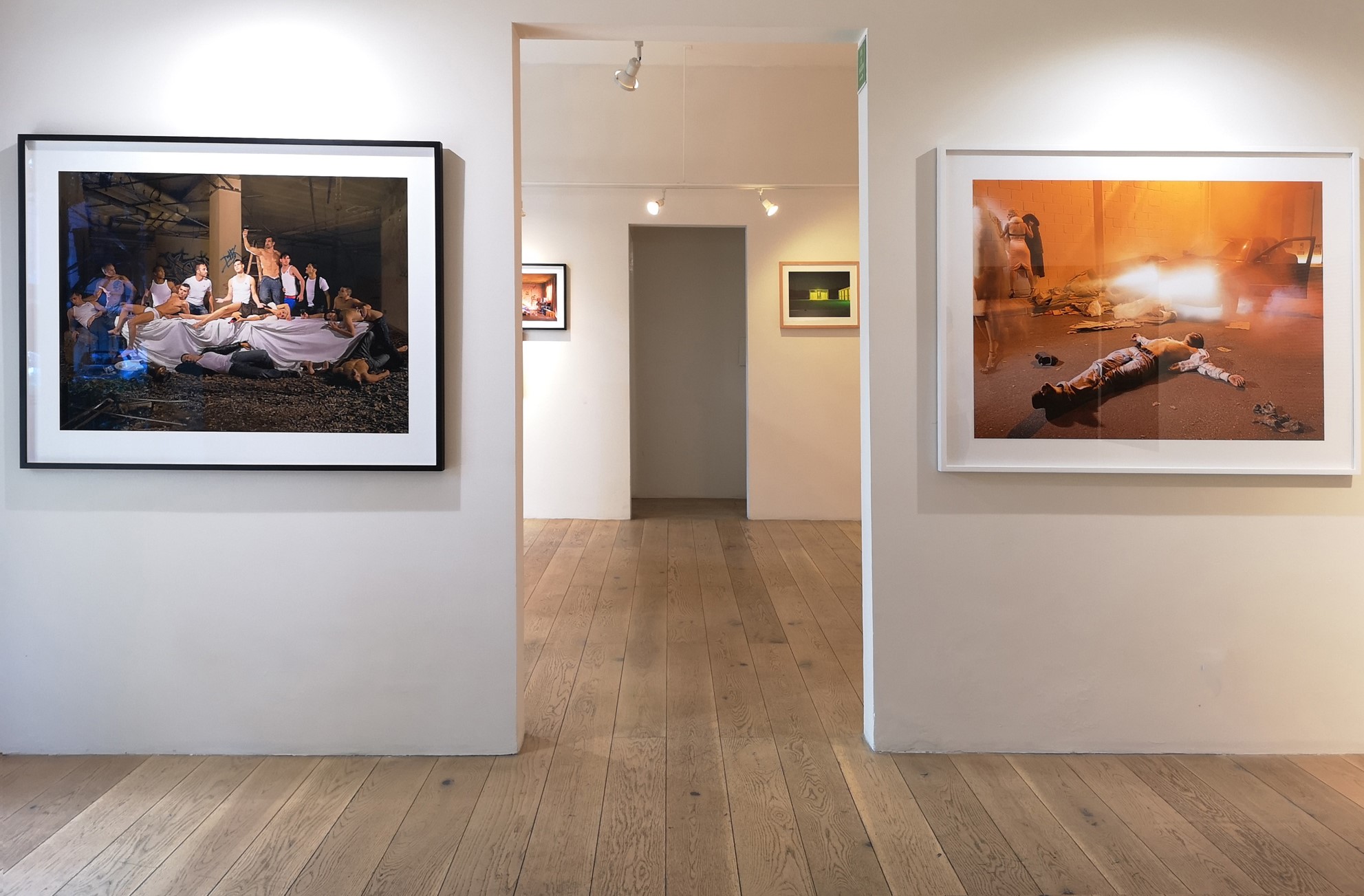
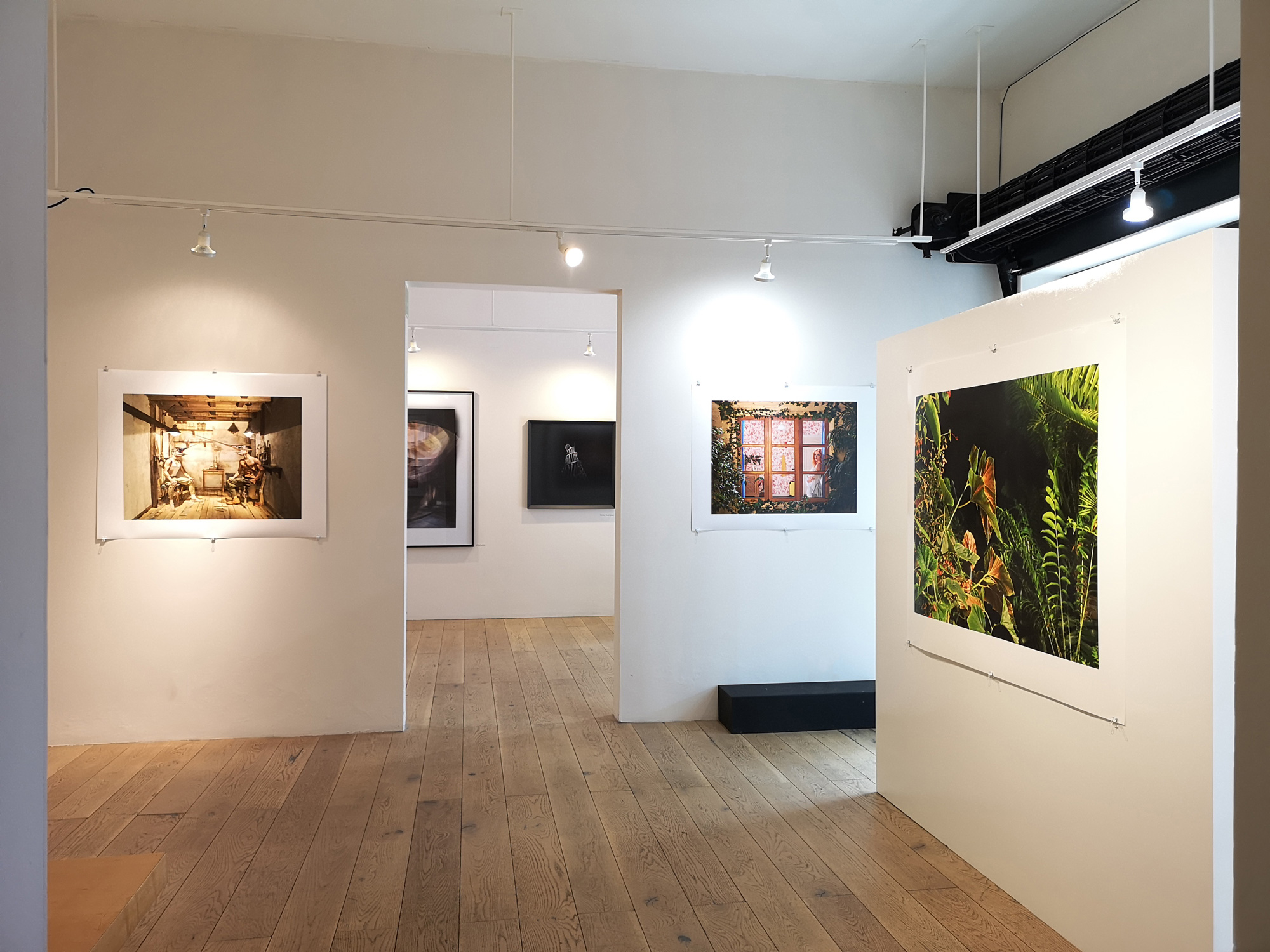
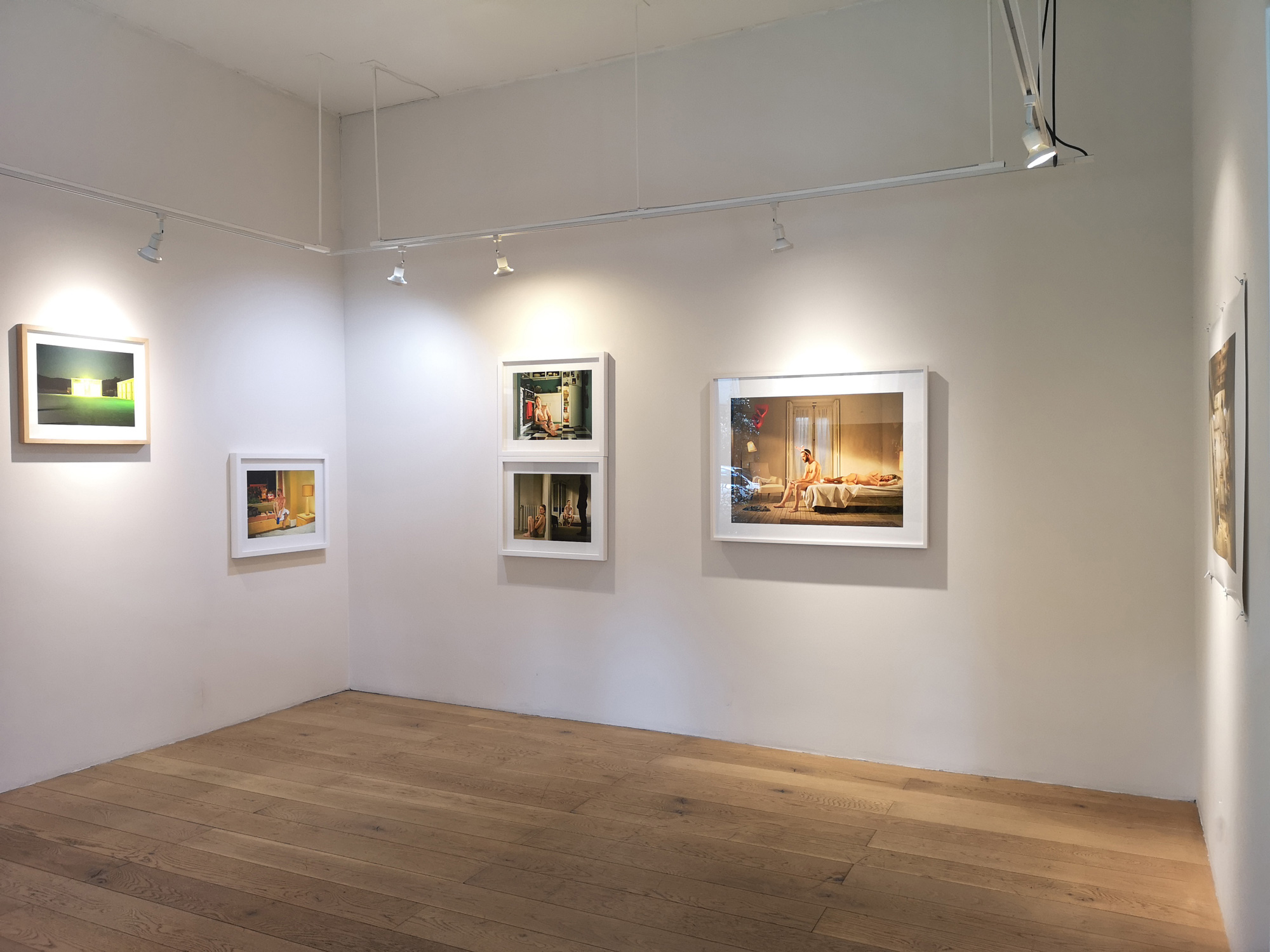
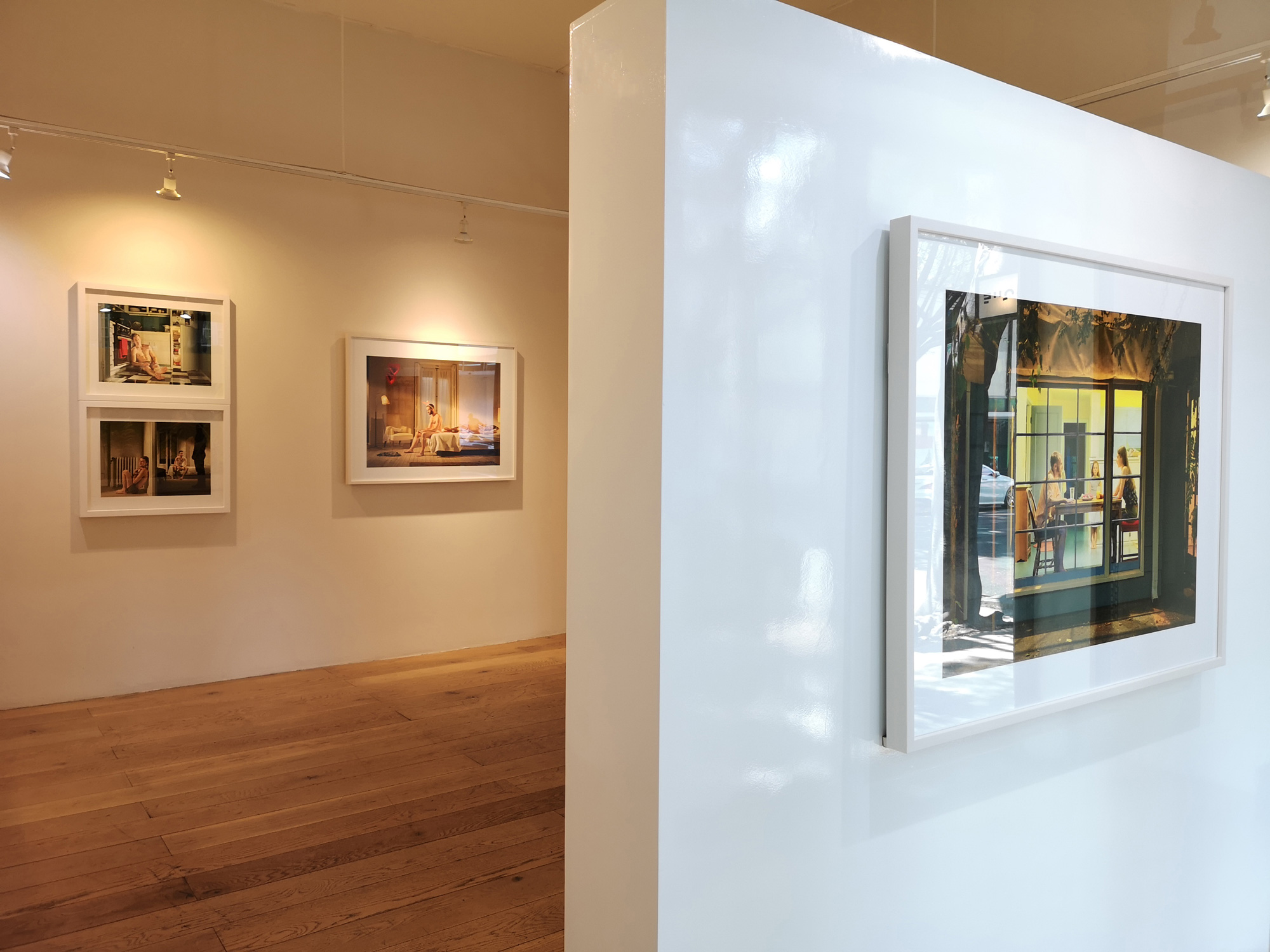
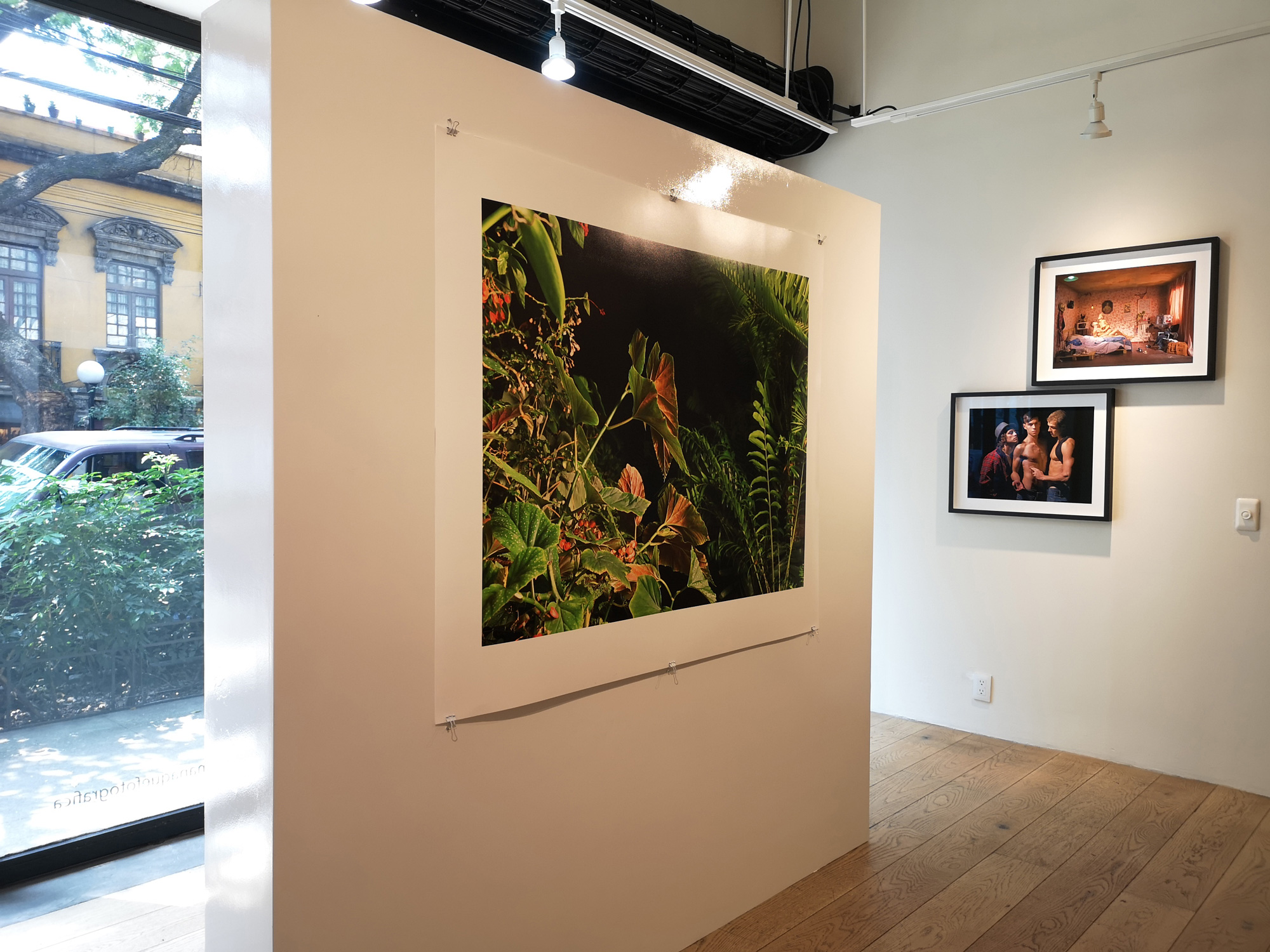
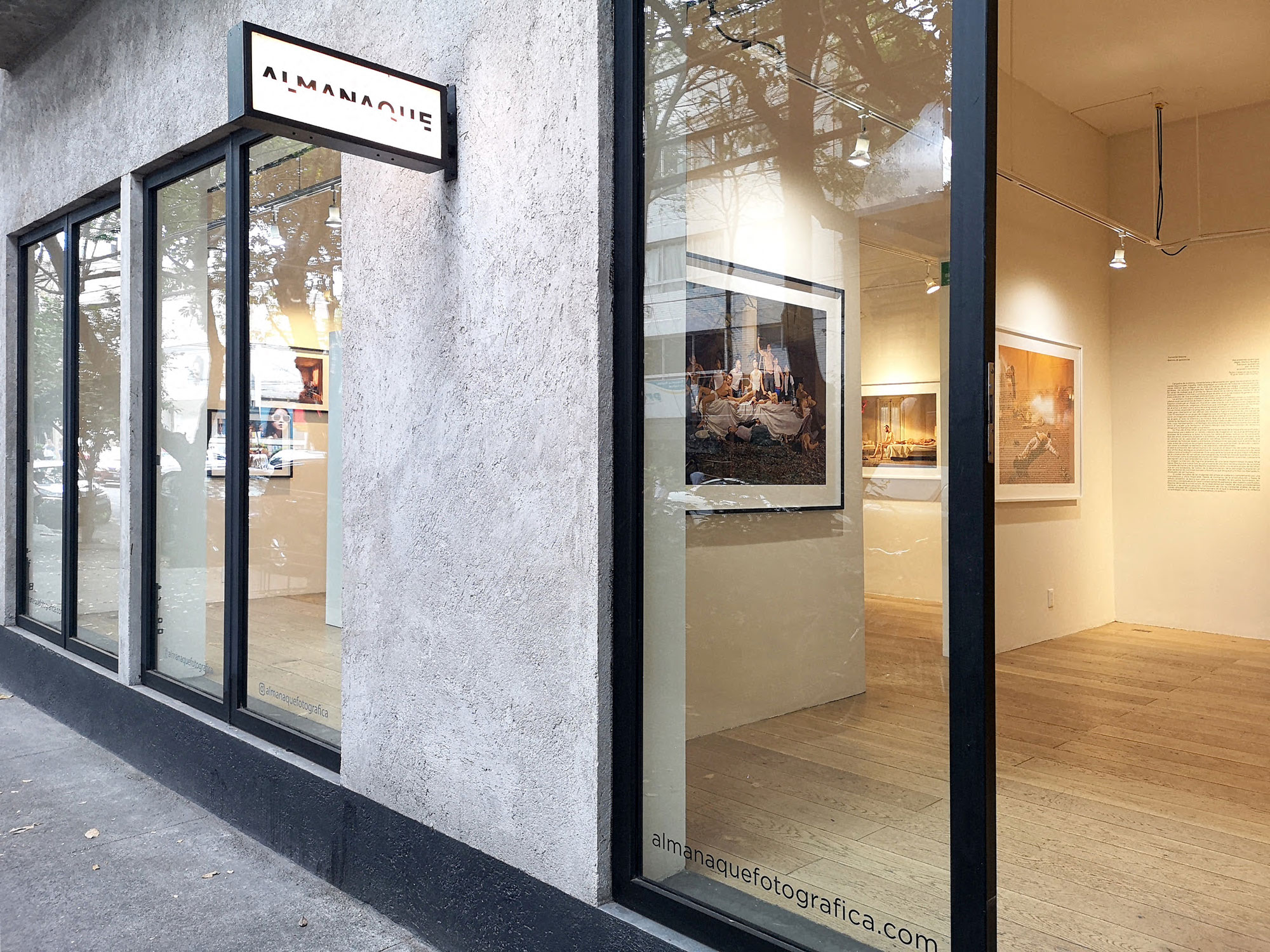
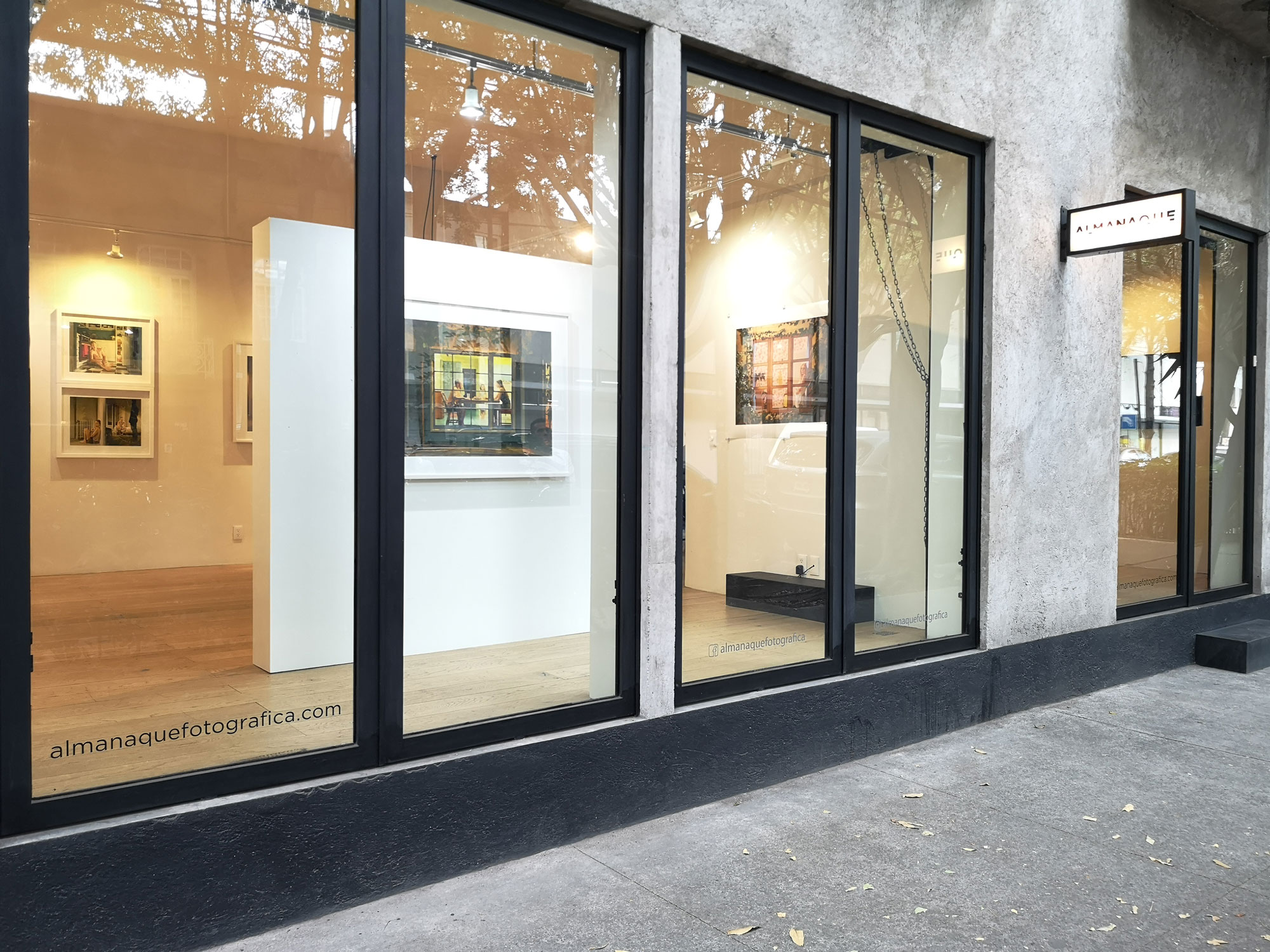
Fernando Bayona
Circus Christi: La última cena
Inkjet print
Ed. S: 3
Ed. M: 3
Ed. L: 2
+2 A.P.
S 65x53 cm
M 106x84 cm
L 135 x 106 cm
A subversive new version of the life of Jesus, located on the periphery of any large city and temporarily set from the 70s until today. A cast of actors undertakes the interpretations of fictional characters that bear great parallels with those that actually appear in the New Testament gospels. The project analyzes the limits of the alteration of History, the freedom of expression and the meaning that dogmatic scorn has in today's society. It thus enters into conflict with the ideological, cultural and economic interests of religious or political groups that try to censor any type of manifestation that threatens the bases on which their sources of power are based. The 14 images that make up Circus Christi represent a contemporary way of life that narrates the intense life of Jesus, the vocalist and leader of the fictional music group Circus Christi. The initial 3 shots are set in the early 70's when his father José, a small-time camel is sentenced in jail, and his mother María is forced to work as a prostitute to support her family.
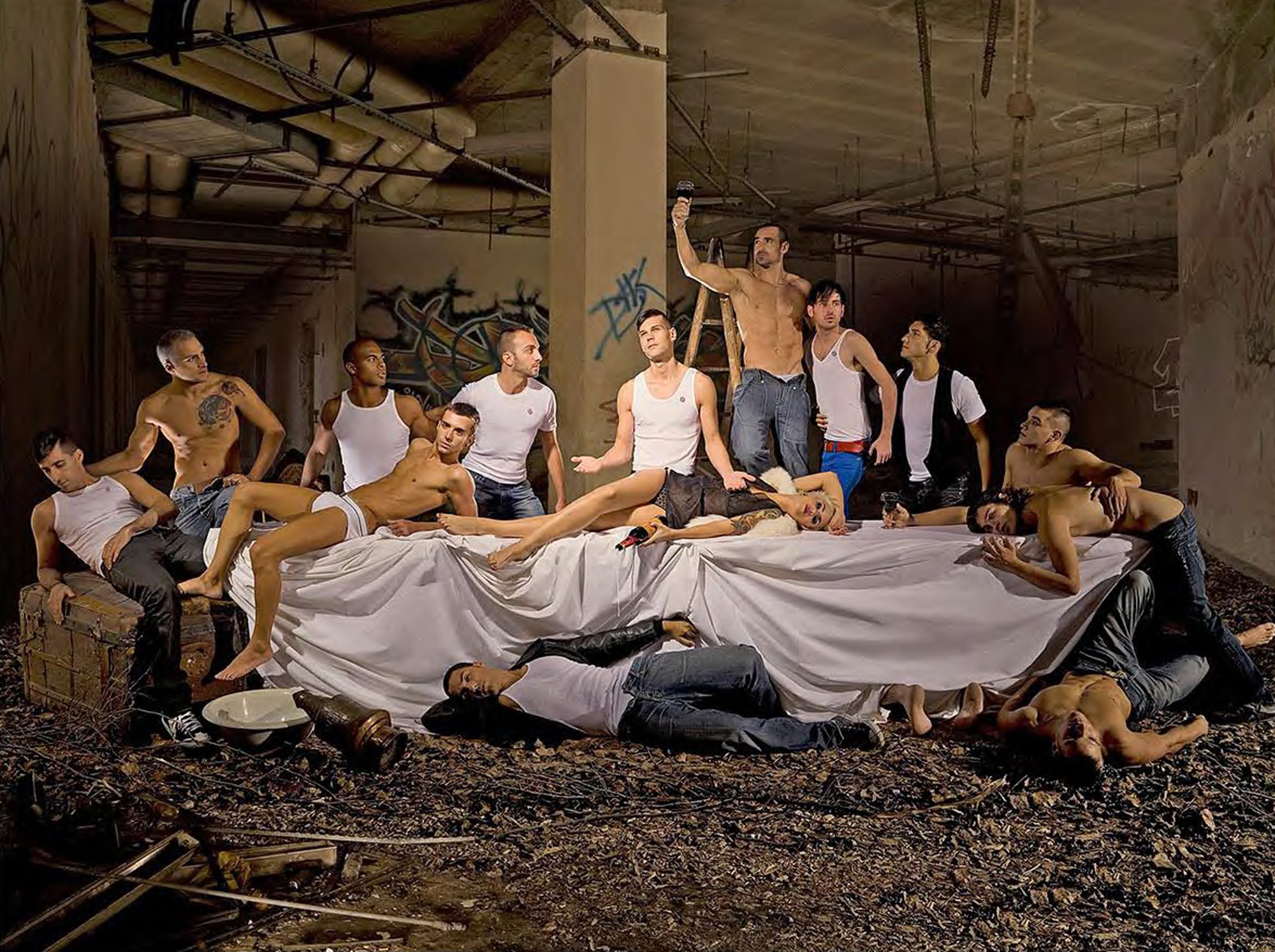
Approximate view with unframed print. Ask for exact available dimensions
Fernando Bayona
Circus Christi: Crucifixión
Inkjet print
Ed. S: 3
Ed. M: 3
Ed. L: 2
+2 A.P.
S 65x53 cm
M 106x84 cm
L 135 x 106 cm
Circus Christi nos propone una subversiva reversión de la vida de Jesús, emplazada en la periferia de cualquier gran ciudad y ambientada temporalmente desde los años 70 hasta nuestros días. Un elenco de actores acomete las interpretaciones de unos personajes ficticios que guardan grandes paralelismos con los que aparecen realmente en los evangelios del Nuevo Testamento. El proyecto analiza los límites de la alteración de la Historia, la libertad de expresión y el significado que el escarnio dogmático poseen en la sociedad actual. Entra así en conflicto con los intereses ideológicos, culturales y económicos de colectivos religiosos o políticos que tratan de censurar cualquier tipo de manifestación que atente contra las bases sobre los que se asientan sus fuentes de poder. Las 14 imágenes que componen Circus Christi suponen un vía crucis contemporáneo que narra la intensa vida de Jesús, el vocalista y líder del ficticio grupo de música Circus Christi. Las 3 tomas iniciales están ambientadas a principios de los años 70 cuando su padre José, un camello de poca monta pasa condena en la cárcel, y su madre María se ve obligada a ejercer la prostitución para sacar adelante a su familia. Ya en la actualidad, Jesús vive con María Magdalena hasta que conoce a Juan Bautista, hecho que cambiará bruscamente su vida desde ese momento y desencadenará los acontecimientos del resto de instantáneas de la serie.
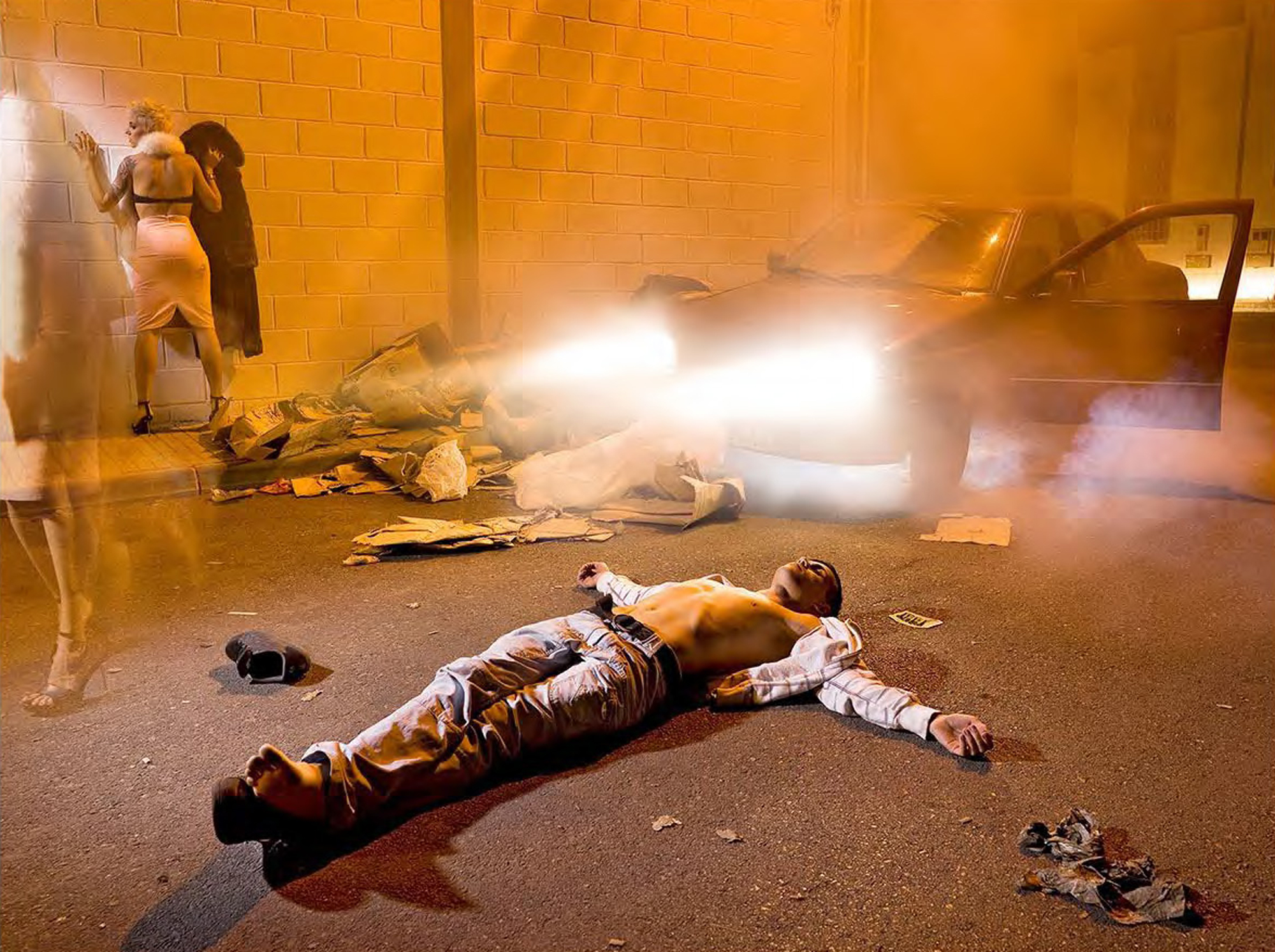
Approximate view with unframed print. Ask for exact available dimensions
Fernando Bayona
Circus Christi: La duda de Tomás
Impresión Ink Jet
Ed 2
135 x 106 cm
A subversive new version of the life of Jesus, located on the periphery of any large city and temporarily set from the 70s until today. A cast of actors undertakes the interpretations of fictional characters that bear great parallels with those that actually appear in the New Testament gospels. The project analyzes the limits of the alteration of History, the freedom of expression and the meaning that dogmatic scorn has in today's society. It thus enters into conflict with the ideological, cultural and economic interests of religious or political groups that try to censor any type of manifestation that threatens the bases on which their sources of power are based. The 14 images that make up Circus Christi represent a contemporary way of life that narrates the intense life of Jesus, the vocalist and leader of the fictional music group Circus Christi. The initial 3 shots are set in the early 70's when his father José, a small-time camel is sentenced in jail, and his mother María is forced to work as a prostitute to support her family.

Approximate view with unframed print. Ask for exact available dimensions
Fernando Bayona
Circus Christi: Jesús y Maria Magdalena
Impresión Ink Jet
Ed 2
135 x 106 cm
A subversive new version of the life of Jesus, located on the periphery of any large city and temporarily set from the 70s until today. A cast of actors undertakes the interpretations of fictional characters that bear great parallels with those that actually appear in the New Testament gospels. The project analyzes the limits of the alteration of History, the freedom of expression and the meaning that dogmatic scorn has in today's society. It thus enters into conflict with the ideological, cultural and economic interests of religious or political groups that try to censor any type of manifestation that threatens the bases on which their sources of power are based. The 14 images that make up Circus Christi represent a contemporary way of life that narrates the intense life of Jesus, the vocalist and leader of the fictional music group Circus Christi. The initial 3 shots are set in the early 70's when his father José, a small-time camel is sentenced in jail, and his mother María is forced to work as a prostitute to support her family.

Approximate view with unframed print. Ask for exact available dimensions
Fernando Bayona
Fernando Bayona
Inkjet print
Ed. S: 3
Ed. M: 3
Ed. L: 2
+2 A.P.
S 65x53 cm
M 106x84 cm
L 135 x 106 cm
Something that happens unexpectedly and places us in a kind of vertex. From that point, it is difficult not to see one's existence as something dividing us forever in before and after. The diagnosis of a disease that will change us without remission, the arrival of someone who gives a turnaround to our universe or a circumstance which shakes the fundaments of what we known. Certainly, the Anglo-Saxon expression Out of the blue can refer to that something good or bad appearing out of nowhere -without previous warning. However, Fernando Bayona has focused its search on that uncertainty that is based within us. Leaving us in a deep state of melancholy. In out of the blue, the Bayona’s story becomes opaque, placing a singular emphasis on life’s mystery, in the eyes of all inexplicable, and that we will pose before the scene photographed in a disturbing diatribe: Something ends to happen, yet that something is in the mood of the characters. In some of these images, our contaminated look could reach erroneous conclusions, perhaps dark and remote. In an interesting shooting that drinks from the cinematographic schemes, Bayona stages a collection of real locations that have been photographed in exceptional light conditions - thanks to a generator moved through out the different scenarios- then post-produced with an intense complex processed addressing the image from a pictorial point of view. The artist, finally, lets us decide how do they correspond to inside or outside, so that the expectation’s experiences and imagination become essential to the story’s interpretation. Pedro Alarcón, Curator, Spain.
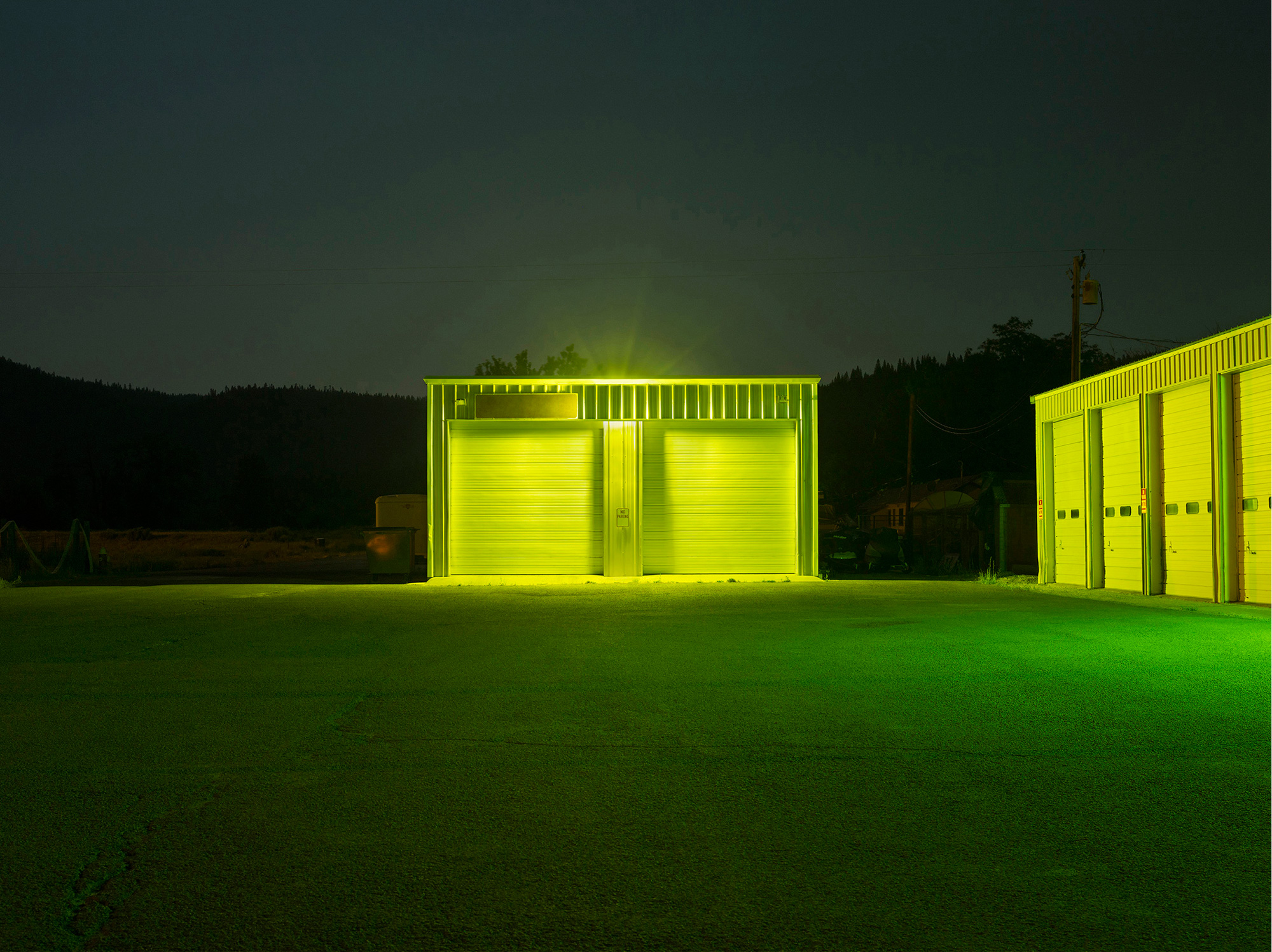
Approximate view with unframed print. Ask for exact available dimensions
Fernando Bayona
The Life of the Other: Motel Capri
Impresión Ink Jet
Ed 2
135 x 106 cm
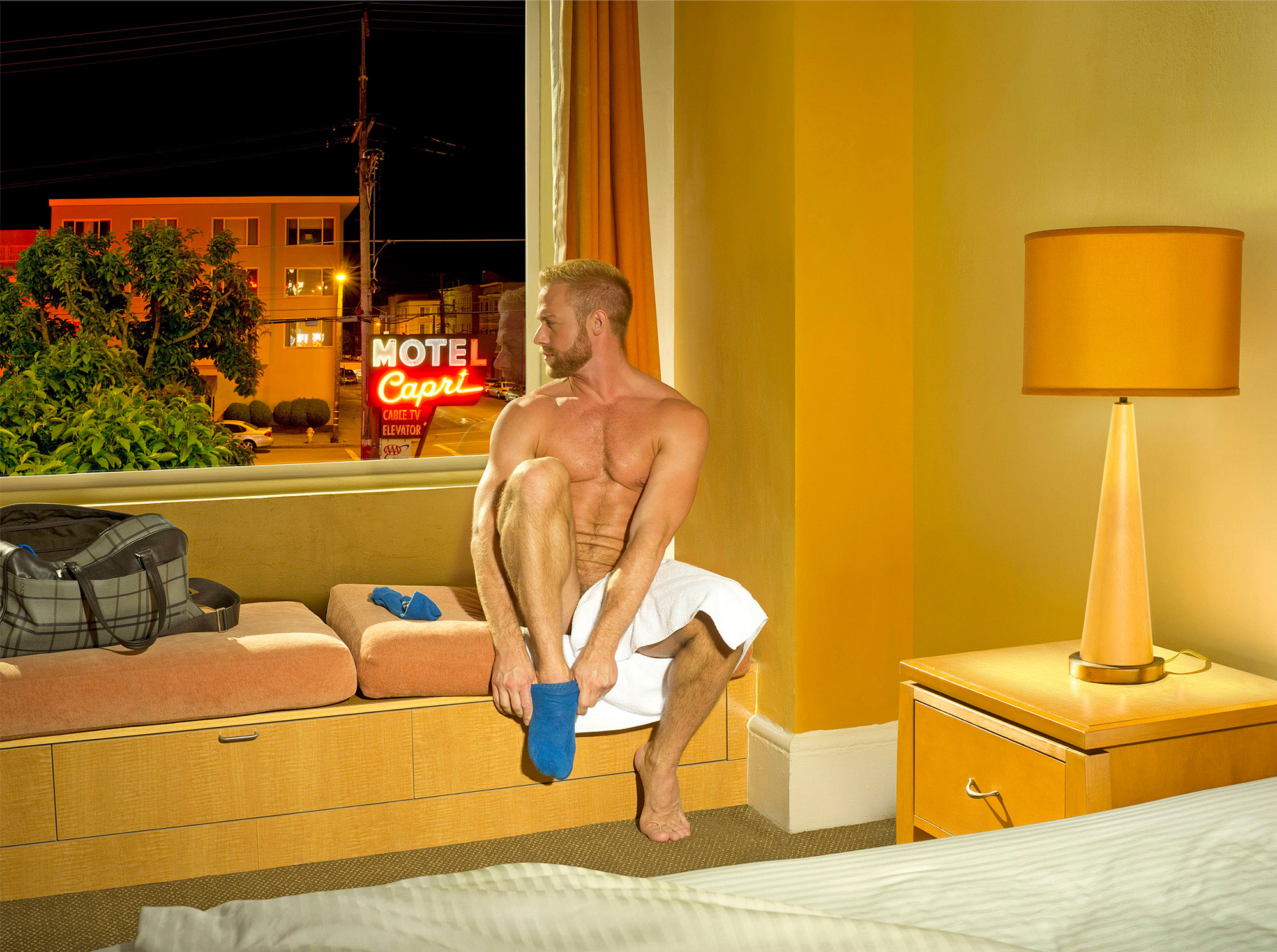
Approximate view with unframed print. Ask for exact available dimensions
Fernando Bayona
The Life of the Other: The Last Time
Impresión Ink Jet
Available in 3 sizes: Ed. 3: 65 x 53 cm, Ed. 3: 106 x 84 cm & Ed. 2: 135 x 106 cm.
65 x 53 cm
A research project halfway between documentary and staged photography composed of 16 images, the project reflects on the use of the body as work support by three professional collectives, that is, as an object of intangible desire, in the case of strippers or porn actors, or those that are subordinated through an economic consideration, in the case of the hustlers The title of the series refers to the game of identities and fictions carried out by these workers to protect their privacy. A sort of "alter egos" or virtual masks that dissociate them from their person, a construct of themselves created to develop their profession through the representation of a feigned character, which mutates to adapt to the work demands or demands of different clients, thus becoming - consciously or unconsciously - permanent actors of the same and endowing it with a very specific life and characteristics. The initial phase of the project is based on interviews with the different participants of the study, thus realizing an approach to the real person, depriving it of the protective device of the mask to be able to understand its reality, its experiences and experiences. Starting from the stories obtained, the project reconstructs photographically some of the passages of its intense life, a mise en scène that gives visibility to stories that tend to be hidden by shame or fear of social rejection due to the stigmatization of the profession, a way to make public something that in nature is very intimate and personal. The characters appearing in each image are played by professional actors, who feel and suffer the lives of the real protagonists, and mix with them who reinterpret their own experiences. This is established as a strategy agreed with each and every one of them to preserve their anonymity despite showing their face before the camera. A double fiction, that of the character that this typology of professionals creates for themselves and protects them from society, and that they have to interpret in the photographic capture within the project, generating permanent doubt in the viewer who does not know who is the real and who the interpreter or interpreted. The project explores the special life characteristics of these workers, deepening in issues such as repressed desire, relationships, affective problems, the cultural environment, immigration, the profile of clients, different sexual practices, illness , loneliness, social stigma or double standards of citizenship among many other tangential issues. A kind of parallel reality in which economic, cultural, religious, health, or simple personal decisions are interrelated that tend to occur in the limits between the public and the private. Fernando, Bayona, Spain. El proyecto reflexiona sobre el uso del cuerpo como soporte laboral por tres colectivos profesionales, esto es, como objeto de deseo intangible, caso de los stripper o actores porno, o bien aquellos que son subordinables a través de una contraprestación económica, en el caso de los chaperos. El título de la serie hace referencia al juego de identidades y ficciones llevadas a cabo por estos trabajadores para proteger su intimidad. Una suerte de "álter egos" o máscaras virtuales que los disocia de su persona, un constructo de sí mismos creado para desarrollar su profesión mediante la representación de un personaje fingido, que muta para adaptarse a las exigencias laborales o demandas de los diferentes clientes, convirtiéndose así -consciente o inconscientemente- en actores permanentes del mismo y dotándolo de una vida y características muy concretas. La fase inicial del proyecto se fundamenta en entrevistas a los diferentes participantes del estudio, realizando así un acercamiento a la persona real, desproveyéndola del artificio protector de la máscara para poder comprender su realidad, sus vivencias y experiencias. Partiendo de los relatos obtenidos el proyecto reconstruye fotográficamente alguno de los pasajes de su intensa vida, una mise en scène que da visibilidad a historias que tienden a ser ocultadas por vergüenza o miedo al rechazo social debido a la estigmatización de la profesión ejercida, un modo de hacer público algo que en naturaleza es muy íntimo y personal. De este modo, los personajes que aparecen en cada una de las imágenes son interpretados por actores profesionales, que sienten y padecen las vidas de los protagonistas reales, y se mezclan con éstos que reinterpretan nuevamente sus propias vivencias. Esto se establece como estrategia pactada con todos y cada uno de ellos para preservar su anonimato a pesar de mostrar su rostro ante la cámara. Creamos así una doble ficción, la del personaje que esta tipología de profesionales crean para sí y los protege de la sociedad, y el que han de interpretar en la toma fotográfica dentro del proyecto, generando la duda permanente en el espectador que no sabe quien es el real y quien el intérprete o interpretado. El proyecto indaga en las especiales características de vida de estos trabajadores, profundizando en cuestiones como el deseo reprimido, las relaciones de pareja, los problemas afectivos, el entorno cultural, la inmigración, el perfil de los clientes, las diferentes prácticas sexuales, la enfermedad, la soledad, el estigma social o la doble moral de la ciudadanía entre otras múltiples cuestiones tangenciales. Una suerte de realidad paralela en la que se interrelacionan condicionantes económicos, culturales, religiosos, sanitarios, o simples decisiones personales que tienden a darse en los límites entre lo público y lo privado.
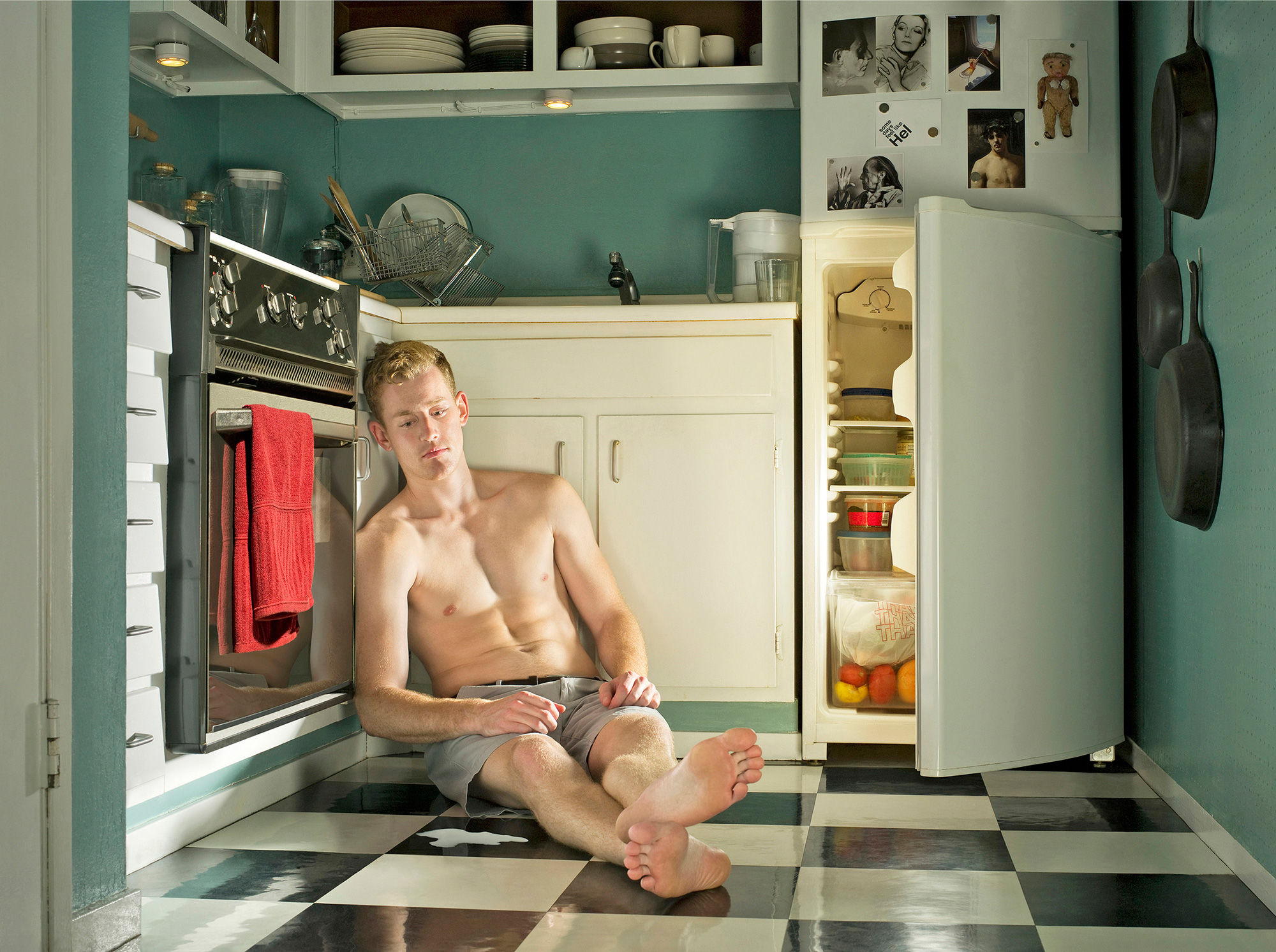
Approximate view with unframed print. Ask for exact available dimensions
Fernando Bayona
The Life of the Other: The client
Impresión Ink Jet
Available in 3 sizes: Ed. 3: 65 x 53 cm, Ed. 3: 106 x 84 cm & Ed. 2: 135 x 106 cm.
65 x 53 cm
A research project halfway between documentary and staged photography composed of 16 images, the project reflects on the use of the body as work support by three professional collectives, that is, as an object of intangible desire, in the case of strippers or porn actors, or those that are subordinated through an economic consideration, in the case of the hustlers The title of the series refers to the game of identities and fictions carried out by these workers to protect their privacy. A sort of "alter egos" or virtual masks that dissociate them from their person, a construct of themselves created to develop their profession through the representation of a feigned character, which mutates to adapt to the work demands or demands of different clients, thus becoming - consciously or unconsciously - permanent actors of the same and endowing it with a very specific life and characteristics. The initial phase of the project is based on interviews with the different participants of the study, thus realizing an approach to the real person, depriving it of the protective device of the mask to be able to understand its reality, its experiences and experiences. Starting from the stories obtained, the project reconstructs photographically some of the passages of its intense life, a mise en scène that gives visibility to stories that tend to be hidden by shame or fear of social rejection due to the stigmatization of the profession, a way to make public something that in nature is very intimate and personal. The characters appearing in each image are played by professional actors, who feel and suffer the lives of the real protagonists, and mix with them who reinterpret their own experiences. This is established as a strategy agreed with each and every one of them to preserve their anonymity despite showing their face before the camera. A double fiction, that of the character that this typology of professionals creates for themselves and protects them from society, and that they have to interpret in the photographic capture within the project, generating permanent doubt in the viewer who does not know who is the real and who the interpreter or interpreted. The project explores the special life characteristics of these workers, deepening in issues such as repressed desire, relationships, affective problems, the cultural environment, immigration, the profile of clients, different sexual practices, illness , loneliness, social stigma or double standards of citizenship among many other tangential issues. A kind of parallel reality in which economic, cultural, religious, health, or simple personal decisions are interrelated that tend to occur in the limits between the public and the private. Fernando, Bayona, Spain.
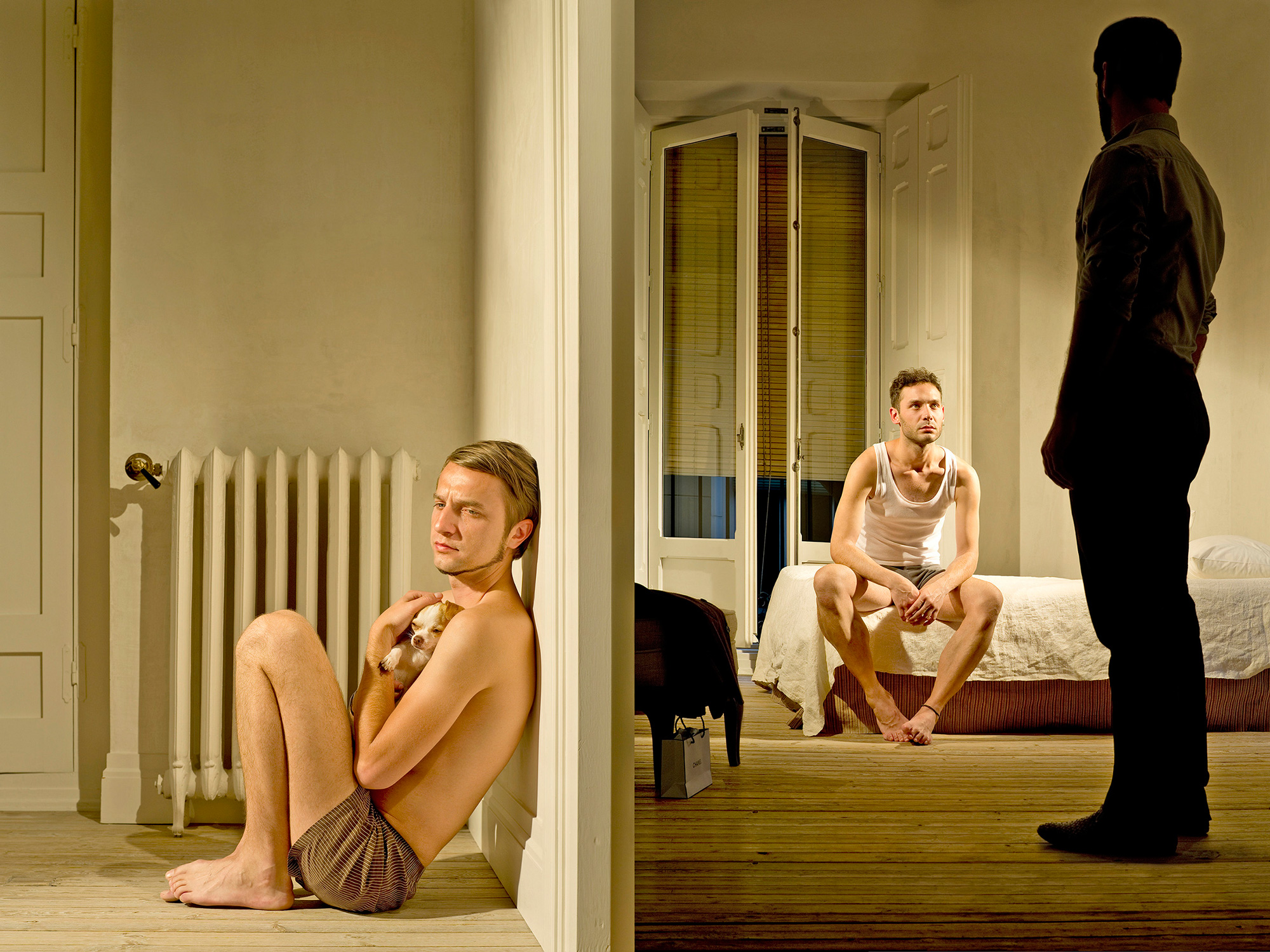
Approximate view with unframed print. Ask for exact available dimensions
Fernando Bayona
The Life of the Other: The News
Inkjet print
Ed. S: 3
Ed. M: 3
Ed. L: 2
+2 A.P.
S 65x53 cm
M 106x84 cm
L 135 x 106 cm
A research project halfway between documentary and staged photography composed of 16 images, the project reflects on the use of the body as work support by three professional collectives, that is, as an object of intangible desire, in the case of strippers or porn actors, or those that are subordinated through an economic consideration, in the case of the hustlers The title of the series refers to the game of identities and fictions carried out by these workers to protect their privacy. A sort of "alter egos" or virtual masks that dissociate them from their person, a construct of themselves created to develop their profession through the representation of a feigned character, which mutates to adapt to the work demands or demands of different clients, thus becoming - consciously or unconsciously - permanent actors of the same and endowing it with a very specific life and characteristics. The initial phase of the project is based on interviews with the different participants of the study, thus realizing an approach to the real person, depriving it of the protective device of the mask to be able to understand its reality, its experiences and experiences. Starting from the stories obtained, the project reconstructs photographically some of the passages of its intense life, a mise en scène that gives visibility to stories that tend to be hidden by shame or fear of social rejection due to the stigmatization of the profession, a way to make public something that in nature is very intimate and personal. The characters appearing in each image are played by professional actors, who feel and suffer the lives of the real protagonists, and mix with them who reinterpret their own experiences. This is established as a strategy agreed with each and every one of them to preserve their anonymity despite showing their face before the camera. A double fiction, that of the character that this typology of professionals creates for themselves and protects them from society, and that they have to interpret in the photographic capture within the project, generating permanent doubt in the viewer who does not know who is the real and who the interpreter or interpreted. The project explores the special life characteristics of these workers, deepening in issues such as repressed desire, relationships, affective problems, the cultural environment, immigration, the profile of clients, different sexual practices, illness , loneliness, social stigma or double standards of citizenship among many other tangential issues. A kind of parallel reality in which economic, cultural, religious, health, or simple personal decisions are interrelated that tend to occur in the limits between the public and the private.
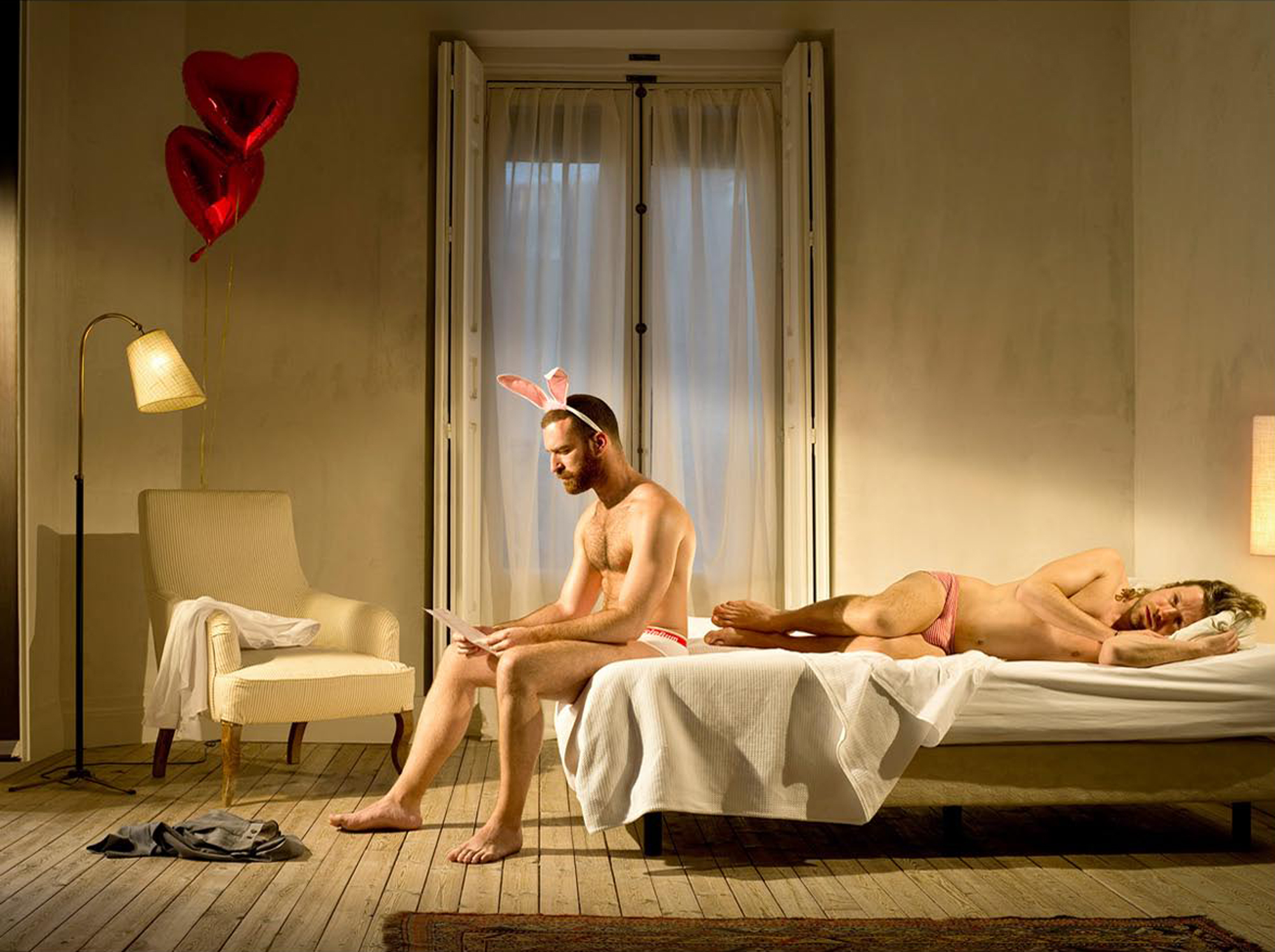
Approximate view with unframed print. Ask for exact available dimensions
Fernando Bayona
What never was: La lección de Esgrima
135 x 106 cm

Approximate view with unframed print. Ask for exact available dimensions
Fernando Bayona
Out of the Blue: The Dinner
Inkjet print
Ed. S: 3
Ed. M: 3
Ed. L: 2
+2 A.P.
S 65x53 cm
M 106x84 cm
L 135 x 106 cm
Algo que ocurre inesperadamente, que nos sitúa en una especie de vértice. Desde ese punto, es difícil no ver la propia existencia como algo que se divide para siempre en un antes y un después. Puede ser el diagnóstico de una enfermedad que nos cambiará sin remisión, la llegada de alguien que da un vuelco a nuestro universo o una circunstancia que haga inestable nuestra construcción de lo conocido. Ciertamente, la expresión anglosajona Out of the blue puede referirse a ese algo que aparece de la nada -sin previo avisotanto en sentido positivo como en negativo. Sin embargo, Fernando Bayona ha centrado su búsqueda en esa incertidumbre que se asienta en nosotros, dejándonos en un profundo estado de melancolía. Quienes recuerdan su serie fotográfica The life of the other (2013/14) comprenderán que esta investigación parece deudora de aquella, por cuanto constituía la representación de un compendio de inquietudes humanas en las que el punto de inflexión se erigía como auténtico recurso narrativo, situando al espectador en un tiempo suspendido. En out of the blue el relato se nos opaca, poniendo un singular énfasis en aquello misterioso de la vida, a los ojos de todos inexplicable, y que nos planteará ante la escena fotografiada en una inquietante diatriba: Algo acaba de suceder, pero ese algo está en el ánimo de los personajes. En buena parte de estas imágenes, nuestra mirada contaminada podría llegar a conclusiones erróneas, muchas de las veces oscuras y remotas. En un interesante contraplano que bebe de los esquemas cinematográficos, Bayona exhibe una colección de localizaciones reales que han sido fotografiadas en condiciones excepcionales de luz -gracias a un generador propio que trasladaba a los diferentes escenarios- y postproducidas en un intensísimo y complejo procesado que aborda la imagen desde planteamientos cercanos a lo pictórico. El artista, por último, nos deja decidir de qué forma se corresponden interior y exterior, de manera que las vivencias y el imaginario de los receptores se convierten en esenciales para la interpretación del relato.
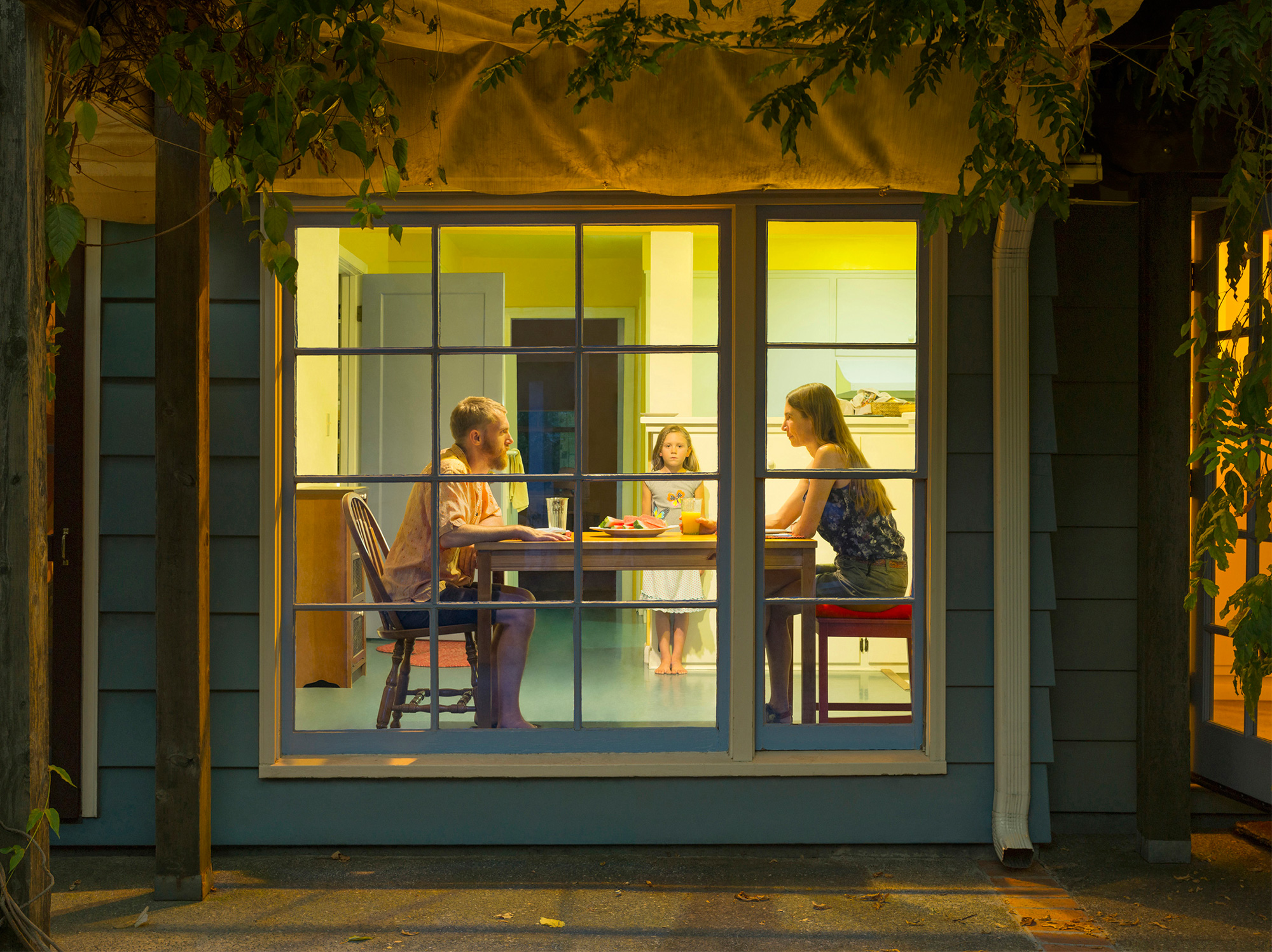
Approximate view with unframed print. Ask for exact available dimensions
Fernando Bayona
Out of the Blue: Still Life
Impresión Ink Jet
Available in 3 sizes: Ed. 3: 65 x 53 cm, Ed. 3: 106 x 84 cm & Ed. 2: 135 x 106 cm.
135 x 106 cm
Something that happens unexpectedly and places us in a kind of vertex. From that point, it is difficult not to see one's existence as something dividing us forever in before and after. The diagnosis of a disease that will change us without remission, the arrival of someone who gives a turnaround to our universe or a circumstance which shakes the fundaments of what we known. Certainly, the Anglo-Saxon expression Out of the blue can refer to that something good or bad appearing out of nowhere -without previous warning. However, Fernando Bayona has focused its search on that uncertainty that is based within us. Leaving us in a deep state of melancholy. In out of the blue, the Bayona’s story becomes opaque, placing a singular emphasis on life’s mystery, in the eyes of all inexplicable, and that we will pose before the scene photographed in a disturbing diatribe: Something ends to happen, yet that something is in the mood of the characters. In some of these images, our contaminated look could reach erroneous conclusions, perhaps dark and remote. In an interesting shooting that drinks from the cinematographic schemes, Bayona stages a collection of real locations that have been photographed in exceptional light conditions - thanks to a generator moved through out the different scenarios- then post-produced with an intense complex processed addressing the image from a pictorial point of view. The artist, finally, lets us decide how do they correspond to inside or outside, so that the expectation’s experiences and imagination become essential to the story’s interpretation. Pedro Alarcón, Curator, Spain.
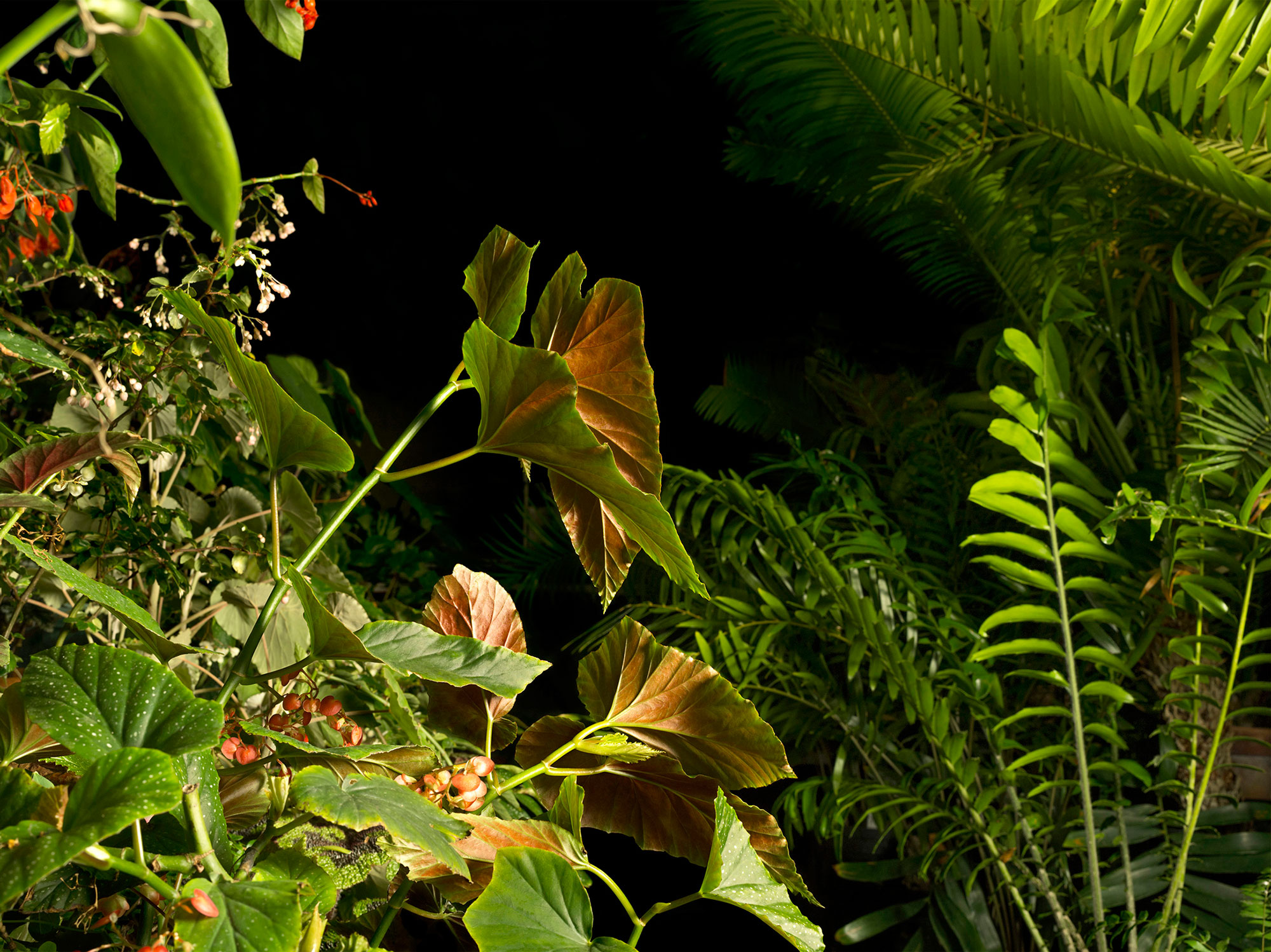
Approximate view with unframed print. Ask for exact available dimensions
hoy prevenido quiero que,
alegre, liberal y lisonjero,
fabriques apariencias
que, de dudas
se pasen a evidencias.
Pedro Calderón de la Barca - “El gran teatro del mundo”
Fernando Bayona
Aparato de Apariencias
Cargados de erotismo, romanticismo y desencanto por igual, los escenarios de Fernando Bayona (Jaén, España, 1980) despliegan un conjunto de historias individuales y escenas íntimas que indagan en lo más profundo de la psicología universal contemporánea. De carácter retrospectivo, Aparato de Apariencias exhibe diversas imágenes de series de trabajo que el artista ha desarrollado en la última década, dando fe de la evolución estilística, formal y conceptual que se asienta en la necesidad de generar un retrato colectivo de una sociedad desilusionada con su realidad.
La primera muestra individual del artista español en México toma su nombre del célebre auto sacramental de Pedro Calderón de la Barca El gran teatro del mundo (1655). Bayona construye un theatrum mundi en cada una de sus composiciones plagadas de referencias históricas, religiosas y filosóficas que convergen en la búsqueda de representar al amor y al sexo como actos de transgresión artística en contextos actuales.
Circus Christi responde a la pregunta ¿qué pasaría si Jesús naciera en la periferia de cualquier gran metrópoli en las últimas tres décadas y fuera el vocalista de una banda de rock? El resultado es un grupo de imágenes que reconfigura visualmente el usual viacrucis en un imaginario plagado de problemáticas sociales en torno a la ambigüedad sexual, las drogas, el sexo, la violencia y la música. Más allá de la aparente provocación, las atmósferas de Bayona están inspiradas en escenas tradicionales inscritas en la historia del arte, cuya representación y simbología sincrónica disputa las construcciones sociales en torno al “pecado” y la “tentación” al mismo tiempo que rechaza todo tipo de censura y aboga por la libertad de culto y expresión.
En The Life of the Other el artista mezcla las técnicas de la fotografía escenificada y documental para elaborar un retrato colectivo de imágenes en las que se entrelazan la sordidez de la violencia, el dolor, la locura, los celos y el deseo sexual con la vulnerabilidad del amor, la ternura, la pasión o la belleza. Las apariencias que surgen de esta serie se centran en la capacidad de generar narrativas intrínsecas, aunque parciales, que provienen de historias reales y entrevistas a trabajadores sexuales que el artista llevó a cabo antes de construir los propios escenarios y en las que también se abordan cuestiones como la soledad, la represión y las relaciones interpersonales.
Si bien la presencia del cuerpo humano es crucial en el desarrollo del estilo de Bayona, Out of the Blue atestigua su predominante desenvolvimiento en la producción de otros estilos como el bodegón o el paisaje. Es en esta serie en la que se ve una mayor influencia de la construcción de narrativas cinematográficas, donde las mise-en-scénes en conjunto funcionan como la antesala de una ficción determinada que en ocasiones cuestiona la percepción de lo que entendemos como verdad.
La imagen La Elección del Esgrima proviene de una serie experimental titulada What Never Was (Lo que nunca fue), la cual proviene de una libre reinterpretación de La Divina Comedia de Dante y en la que Bayona la presenta como una escena propia de los infiernos en una búsqueda, de nuevo, de la desarticulación de la psicología humana en un afán de liberar los controles sociales y filosóficos que bloquean y limitan las libertades individuales del ser humano.
El poder narrativo de las imágenes del artista se sostiene y complementa por una manufactura y oficio impecable. Desde el momento de la preproducción y hasta la edición posterior, se busca que cada uno de los detalles de encuadre, iluminación, disposición y conceptualización sean cuidadosamente planeados, ejecutados y justificados. Bayona defiende la construcción de su teatralidad por medio de estos procedimientos técnicos y de conceptualización, continuando así con su constante análisis de las nociones centrales del comportamiento humano en el que lo autobiográfico y lo reflexivo se entretejen con lo religioso, lo documental y lo político.
Alberto Ríos de la Rosa, Historiador de arte.